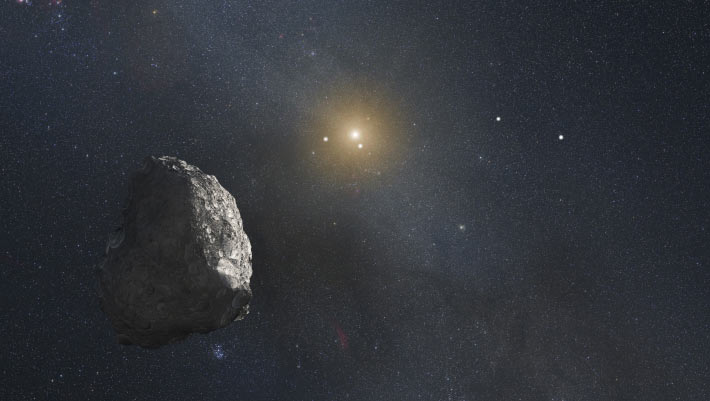Discovered by the Large inclination Distant Objects (LiDO) survey and designated 2020 VN40, this trans-Neptunian object is the first confirmed body that orbits the Sun once for every 10 orbits Neptune completes. This discovery, reported in paper in the Planetary Science Journal, helps scientists understand how objects in the outer Solar System behave and how they got there. It supports the idea that many distant objects are temporarily ‘caught’ in Neptune’s gravity as they drift through space.
An artist’s impression of a trans-Neptunian object. Image credit: NASA / ESA / G. Bacon, STScI.
“This is a big step in understanding the outer Solar System,” said Dr. Rosemary Pike, an astronomer at the Harvard & Smithsonian’s Center for Astrophysics.
“It shows that even very distant regions influenced by Neptune can contain objects, and it gives us new clues about how the Solar System evolved.”
“This is just the beginning,” said Dr. Kathryn Volk, an astronomer at the Planetary Science Institute.
“We’re opening a new window into the Solar System’s past.”
2020 VN40 was discovered by the LiDO survey, which searched for unusual objects in the outer Solar System.
This survey used the Canada-France-Hawaii Telescope for the main survey operations, and Gemini Observatory and Magellan Baade for additional observations.
The survey was designed to search for bodies with orbits that extend far above and below the plane of the Earth’s orbit around the Sun, part of the outer Solar System that hasn’t been well-studied.
“It has been fascinating to learn how many small bodies in the Solar System exist on these very large, very tilted orbits,” said Dr. Samantha Lawler, an astronomer at the University of Regina and a member of the LiDO team.
2020 VN40’s average distance is about 139.5 times farther from the Sun than Earth and follows a very tilted path around the Solar System.
What makes the object even more interesting is how it moves compared to Neptune.
Most objects with a simple ratio of the duration of their orbit compared to the duration of Neptune’s orbit always come closest to the Sun when Neptune is far away.
In contrast, 2020 VN40 comes closest to the Sun when Neptune is very close by, if you look at their positions from above the Solar System.
The tilt of the object’s orbit means that the objects are not actually close, because 2020 VN40 is actually far below the Solar System — they only appear close when flattened onto a map.
All other known resonant trans-Neptunian objects orbit such that they avoid this alignment at their closest approach to the Sun, even in the flattened view.
“This new motion is like finding a hidden rhythm in a song we thought we knew,” said Dr. Ruth Murray-Clay, an astronomer at the University of California, Santa Cruz.
“It could change how we think about the way distant objects move.”
_____
Rosemary E. Pike et al. 2025. LiDO: Discovery of a 10:1 Resonator with a Novel Libration State. Planet. Sci. J 6, 156; doi: 10.3847/PSJ/addd22
